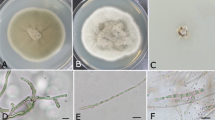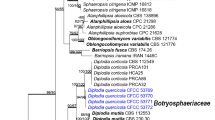Abstract
Species of Mycosphaerellaceae and Teratosphaeriaceae (Ascomycetes) cause important leaf, shoot and canker diseases globally on a broad range of hosts, including Eucalyptus and other Myrtaceae. Recently, species of the Mycosphaerellaceae and Teratosphaeriaceae have been isolated as asymptomatic endophytes. In this study, endophytic species of Mycosphaerellaceae and Teratosphaeriaceae were isolated from samples taken from healthy native Syzygium cordatum (Myrtaceae) and related non-native Eucalyptus grandis x E. camaldulensis (hybrid clone) growing in Mtubatuba, KwaZulu Natal, South Africa. Multi-locus sequence analysis (MLSA) using the Internal Transcribed Spacer (ITS) region, the partial Large Subunit (LSU; 28S nrDNA) of the nuclear ribosomal DNA operon and Translation Elongation Factor-1α (TEF-1α) genes were used to correctly identify the 22 resulting isolates. The isolates grouped in five clades representing Readeriella considenianae that was isolated only from the Eucalyptus hybrid clone, Mycosphaerella marksii and M. vietnamensis from S. cordatum and Pseudocercospora crystallina from both S. cordatum and the Eucalyptus hybrid clone. Interestingly, the serious canker pathogen T. zuluensis was isolated from Eucalyptus leaves, although it is known only from stem and branch cankers. Of the species found, R. considenianae and M. vietnamensis were found in South Africa for the first time, while M. marksii, M. vietnamensis and P. crystallina were shown to naturally infect native S. cordatum for the first time. Despite the limited number of trees sampled, the new host and distribution reports show that more intensive sampling, especially following an endophyte approach, will reveal more complete patterns of host preference and geographical distribution for these fungi.




Similar content being viewed by others
References
Andjic V, Whyte G, Hardy G, Burgess T (2010) New Teratosphaeria species occurring on eucalypts in Australia. Fungal Divers 43:27–38
Bensch K, Groenewald JZ, Dijksterhuis J, Starink-Willemse M, Andersen B, Summerell BA, Shin HD, Dugan FM, Schroers HJ, Braun U (2010) Species and ecological diversity within the Cladosporium cladosporioides complex (Davidiellaceae, Capnodiales). Stud Mycol 67:1–94
Burgess TI, Barber PA, Sufaati S, Xu D, Hardy Gest JDB (2007) Mycosphaerella spp. on Eucalyptus in Asia; new species, new hosts and new records. Fungal Divers 24:135–157
Carbone I, Kohn LM (1990) A method for designing primer sets for speciation studies in filamentous ascomycetes. Mycologia 91:553–556
Chen SF, Barnes I, Chungu D, Roux J, Wingfield MJ, Xie YJ, Zhou XD (2011) High population diversity and increasing importance of the Eucalyptus stem canker pathogen, Teratosphaeria zuluensis, in South China. Australas Plant Pathol 40:407–415
Corlett M (1995) An annotated list of the published names in Mycosphaerella and Sphaerella: corrections and additions. Mycotaxon 53:37–56
Cortinas MN, Barnes I, Wingfield MJ, Wingfield BD (2010) Genetic diversity in the Eucalyptus stem pathogen Teratosphaeria zuluensis. Australas Plant Pathol 39:383–393
Crous PW (1998) Mycosphaerella spp. and their anamorphs: associated with leaf spot diseases of Eucalyptus. APS Press, St Paul
Crous PW (1999) Species of Mycosphaerella and related anamorphs occurring on Myrtaceae (excluding Eucalyptus). Mycol Res 103:607–621
Crous PW (2009) Taxonomy and phylogeny of the genus Mycosphaerella and its anamorphs. Fungal Divers 38:1–24
Crous PW, Groenewald JZ (2005) Hosts, species and genotypes: opinions versus data. Australas Plant Pathol 34:463–470
Crous PW, Wingfield MJ (1996) Species of Mycosphaerella and their anamorphs associated with leaf blotch disease of Eucalyptus in South Africa. Mycologia 88:441–458
Crous PW, Wingfield MJ, Park RF (1991) Mycosphaerella nubilosa, a synonym of M. molleriana. Mycol Res 95:628–632
Crous PW, Aptroot A, Kang JC, Braun U, Wingfield MJ (2000) The genus Mycosphaerella and its anamorphs. Stud Mycol 45:107–121
Crous PW, Hong L, Wingfield BD, Wingfield MJ (2001a) ITS rDNA phylogeny of selected Mycosphaerella species and their anamorphs occurring on Myrtaceae. Mycol Res 105:425–431
Crous PW, Kang JC, Braun U (2001b) A phylogenetic redefinition of anamorph genera in Mycosphaerella based on ITS rDNA sequence and morphology. Mycologia 93:1081–1101
Crous PW, Groenewald JZ, Mansilla JP, Hunter GC, Wingfield MJ (2004) Phylogenetic reassessment of Mycosphaerella spp. and their anamorphs occurring on Eucalyptus. Stud Mycol 50:195–214
Crous PW, Wingfield MJ, Mansilla JP, Alfenas AC, Groenewald JZ (2006) Phylogenetic reassessment of Mycosphaerella spp. and their anamorphs occurring on Eucalyptus. II. Stud Mycol 55:99–131
Crous PW, Braun U, Groenewald JZ (2007) Mycosphaerella is polyphyletic. Stud Mycol 58:1–32
Crous PW, Groenewald JZ, Summerell BA, Wingfield BD, Wingfield MJ (2009a) Co-occurring species of Teratosphaeria on Eucalyptus. Persoonia 22:38–48
Crous PW, Schoch CL, Hyde KD, Wood AR, Gueidan C, De Hoog GS, Groenewald JZ (2009b) Phylogenetic lineages in the Capnodiales. Stud Mycol 64:17–47
Crous PW, Summerell BA, Carnegie AJ, Wingfield MJ, Hunter GC, Burgess TI, Andjic V, Barber PA, Groenewald JZ (2009c) Unravelling Mycosphaerella: do you believe in genera? Persoonia 23:99–118
Crous PW, Wingfield MJ, Groenewald JZ (2009d) Niche sharing reflects a poorly understood biodiversity phenomenon. Persoonia 22:83–94
de Hoog GS, Gerrits van den Ende AHG (1998) Molecular diagnostics of clinical strains of filamentous Basidiomycetes. Mycoses 41:183–189
Farris JS, Kallersjo M, Kluge AG, Bult C (1994) Testing significance of incongruence. Cladistics 10:315–319
Felsenstein J (1985) Confidence limits on phylogenies: an approach using the bootstrap. Evolution 39:783–791
Hillis DM, Huelsenbeck JP (1992) Signal, noise, and reliability in molecular phylogenetic analyses. J Hered 83:189–195
Hunter GC, Roux J, Wingfield BD, Crous PW, Wingfield MJ (2004) Mycosphaerella species causing leaf disease in South African Eucalyptus plantations. Mycol Res 108:672–681
Hunter GC, Wingfield BD, Crous PW, Wingfield MJ (2006) A multi-gene phylogeny for species of Mycosphaerella occurring on Eucalyptus leaves. Stud Mycol 55:147–161
Hunter GC, Crous PW, Carnegie AJ, Wingfield MJ (2009) Teratosphaeria nubilosa, a serious leaf disease pathogen of Eucalyptus spp. in native and introduced areas. Mol Plant Pathol 10:1–14
Hunter GC, Crous PW, Carnegie AJ, Burgess TI, Wingfield MJ (2011) Mycosphaerella and Teratosphaeria diseases of Eucalyptus; easily confused and with serious consequences. Fungal Divers 50:145–166
Hyde KD, Bussaban B, Paulus B, Crous PW, Lee S, McKenzie EHC, Photita W, Lumyong S (2007) Diversity of saprobic microfungi. Biodivers Conserv 16:7–35
Katoh K, Kuma K, Toh H, Miyata T (2005) MAFFT version 5: improvement in accuracy of multiple sequence alignment; http://mafft.cbrc.jp/alignment/software/. Nucleic Acids Res 33:511–518
Maxwell A, Jackson SL, Dell B, Hardy G (2005) PCR-identification of Mycosphaerella species associated with leaf diseases of Eucalyptus. Mycol Res 109:992–1004
Moller EM, Bahnweg G, Sandermann H, Geiger HH (1992) A simple and efficient protocol for isolation of high molecular weight DNA from filamentous fungi, fruit bodies, and infected plant tissues. Nucleic Acids Res 20:6115–6116
Moncalvo JM, Wang HH, Hseu RS (1995) Phylogenetic relationships in Ganoderma inferred from the internal transcribed spacers and 25S ribosomal DNA sequences. Mycologia 87:223–238
Nylander JAA (2004) MrModeltest v2. Program distributed by the author. Evolutionary Biology Centre, Uppsala University; https://github.com/nylander/MrModeltest2
Pavlic D, Slippers B, Coutinho TA, Wingfield MJ (2007) Botryosphaeriaceae occurring on native Syzygium cordatum in South Africa and their potential threat to Eucalyptus. Plant Pathol 56:624–636
Rambaut A, Drummond AJ (2007) Tracer v1. 4;http://tree.bio.ed.ac.uk/software/tracer/
Rehner SA, Samuels GJ (1995) Moleculoar systematics of Hypocreales: a teleomorph gene phylogeny and the status of their anamorphs. Can J Bot 73:816–823
Rodas CA, Roux RJ, van Wyk M, Wingfield BD, Wingfield MJ (2008) Ceratocystis neglecta sp. nov., infecting Eucalyptus trees in Colombia. Fungal Divers 28:73–84
Ronquist F, Huelsenbeck JP (2003) MrBayes 3: Bayesian phylogenetic inference under mixed models. Bioinformatics 19:1572–1574
Sánchez Márquez S, Bills GF, Zabalgogeazcoa I (2011) Fungal species diversity in juvenile and adult leaves of Eucalyptus globulus from plantations affected by Mycosphaerella leaf disease. Ann Appl Biol 158:177–187
Schubert K, Groenewald JZ, Braun U, Dijksterhuis J, Starink M, Hill CF, Zalar P, De Hoog GS, Crous PW (2007) Biodiversity in the Cladosporium herbarum complex (Davidiellaceae, Capnodiales), with standardisation of methods for Cladosporium taxonomy and diagnostics. Stud Mycol 58:105–156
Summerell BA, Groenewald JZ, Carnegie AJ, Summerbell RC, Crous PW (2006) Eucalyptus microfungi known from culture. 2. Alysidiella, Fusculina and Phlogicylindrium genera nova, with notes on some other poorly known taxa. Fungal Divers 23:323–350
Sutton BC, Crous PW (1997) Lecanostictopsis gen. nov., and related leaf-spotting fungi on Syzygium species. Mycol Res 101:215–225
Swofford DL (2003) {PAUP*. Phylogenetic analysis using parsimony (* and other methods). Version 4.}; http://paup.csit.fsu.edu/downl.html
Tamura K, Dudley J, Nei M, Kumar S (2007) MEGA4: molecular evolutionary genetics analysis (MEGA) software version 4.0. Mol Biol Evol 24:1596–1599
Taylor K, Andjic V, Barber PA, Hardy GEJ, Burgess TI (2012) New species of Teratosphaeria associated with leaf diseases on Corymbia calophylla (Marri). Mycol Prog 11:159–169
Vilgalys R, Hester M (1990) Rapid genetic identification and mapping of enzymatically amplified ribosomal DNA from several Cryptococcus species. J Bacteriol 172:4238–4246
White TJ, Bruns T, Lee S and Taylor J (1990) Amplification and direct sequencing of fungal ribosomal RNA genes for phylogenetics. In: PCR protocols a guide to methods and applications, pp. 315–322. Academic Press, New York
Wingfield MJ, Crous PW, Coutinho TA (1996) A serious canker disease of Eucalyptus in South Africa caused by a new species of Coniothyrium. Mycopathologia 136:139–145
Acknowledgments
We thank the Thutuka Funding programme of the National Research Foundation (NRF), members of the Tree Protection Co-operative Programme (TPCP) and the Department of Science and Technology (DST)/NRF Centre of Excellence in Tree Health Biotechnology (CTHB), South Africa for financial support. We are also grateful to Dr Ewald Groenewald (CBS-KNAW Fungal Biodiversity Centre; Netherlands), for his valuable assistance with the data analysis and for helpful suggestions regarding the manuscript. We also thank Miss Kerry-Anne Pillay and Mr Jan Nagel for technical assistance.
Author information
Authors and Affiliations
Corresponding author
Rights and permissions
About this article
Cite this article
Marsberg, A., Slippers, B., Wingfield, M.J. et al. Endophyte isolations from Syzygium cordatum and a Eucalyptus clone (Myrtaceae) reveal new host and geographical reports for the Mycosphaerellaceae and Teratosphaeriaceae. Australasian Plant Pathol. 43, 503–512 (2014). https://doi.org/10.1007/s13313-014-0290-y
Received:
Accepted:
Published:
Issue Date:
DOI: https://doi.org/10.1007/s13313-014-0290-y




